The rapid slide in US Treasury yields is prodding some stablecoin treasuries to diversify.
This week, Spark — the DeFi lending protocol and core “Star” within the Sky (formerly MakerDAO) ecosystem — allocated $100 million of its stablecoin reserves to Superstate’s USCC fund, a regulated crypto carry product that earns yield from futures basis trades instead of solely interest on government debt.
The move comes just as the 10-year Treasury yield dipped below 4% for the first time since April, closing at 3.976%. Lower yields have squeezed protocols that rely on short-duration Treasuries to fund operations and incentives. Spark’s pivot marks one of the first large-scale moves by a major stablecoin issuer away from Treasuries into regulated, crypto-derived yield.
“Access to stable, diversified yield is increasingly critical as Treasury returns compress,” Superstate CEO Robert Leshner said. “The investment allows Spark to maintain exposure to yield opportunities uncorrelated with Federal Reserve rate policy while operating within a compliant institutional framework.”
Sam MacPherson, CEO and co-founder of Phoenix Labs — which developed Spark — said Superstate’s USCC fund enables the protocol to “diversify its reserves while maintaining the same level of safety and compliance Spark always prioritizes.”
USCC uses basis trading strategies that exploit the spread between spot and futures prices on assets such as bitcoin, ether, solana, and XRP. It currently reports a 30-day yield of 8.35%. The strategy benefits from busy derivatives markets, which provide the pricing gaps the fund harvests. CME alone logged more than $900 billion in futures and options volume in Q3, led by ETH.
The product is custodied by Anchorage Digital, audited by Ernst & Young, and calculates its NAV through NAV Fund Services.
Rate compression meets tokenomics overhaul
The USCC allocation comes amid broader changes in the Sky ecosystem as it adapts to a lower-rate environment. A fresh governance proposal would shift staking rewards from being paid in USDS, Sky’s flagship stablecoin, to the SKY token itself. The plan would direct 500 million SKY to the treasury and raise daily buybacks to $300,000 in USDS, with rewards transitioning fully to SKY after 90 days. The change would be reversible if market conditions shift.
This tokenomics revamp follows Sky’s introduction of stUSDS, its first risk capital token. The new instrument is designed for advanced users and institutions willing to take on more protocol risk in exchange for a higher share of system rewards. stUSDS yield is derived from the stability fees paid by borrowers minting USDS against SKY collateral, linking capital formation more directly to protocol revenues.
Rune Christensen, co-founder of Sky, said stUSDS is part of a strategy to bring “maximum effectiveness and efficiency to capital formation” as the protocol scales beyond its original MakerDAO model.
Christiansen is also the top user of the new borrowing option, which could strain liquidity in a crisis.
Sky’s ecosystem has expanded through its autonomous Stars — Spark, Grove, and Keel — which deploy stablecoin reserves into DeFi markets. Spark alone has grown to over $11 billion in total volume locked.
Grove has secured $1 billion in allocations for institutional credit strategies, while Keel is set to bring $2.5 billion in capital to Solana’s on-chain ecosystem.
Spark’s evolving yield mix
Spark’s own Savings product has been expanding in parallel. Its V2 launch this week brings support for USDC, USDT, and ETH, while maintaining a conservative risk framework. Spark Savings currently offers 4.75% APY — about 75 basis points above Aave’s comparable stablecoin yields — primarily from lending against BTC, ETH, and liquid staking tokens.
The USCC allocation represents a measured step into basis-driven, crypto-native yield that remains market-neutral and regulated — a combination DeFi protocols increasingly seek as Treasury returns slide.
For Sky, which oversees more than $9 billion in circulating USDS and DAI across multiple chains, the shift shows how the DAO can maintain flexibility in its treasury strategy, positioning for a lower rate environment where yield will have to come from new sources.
Get the news in your inbox. Explore Blockworks newsletters:
Source: https://blockworks.co/news/sky-pivots-beyond-treasuries



